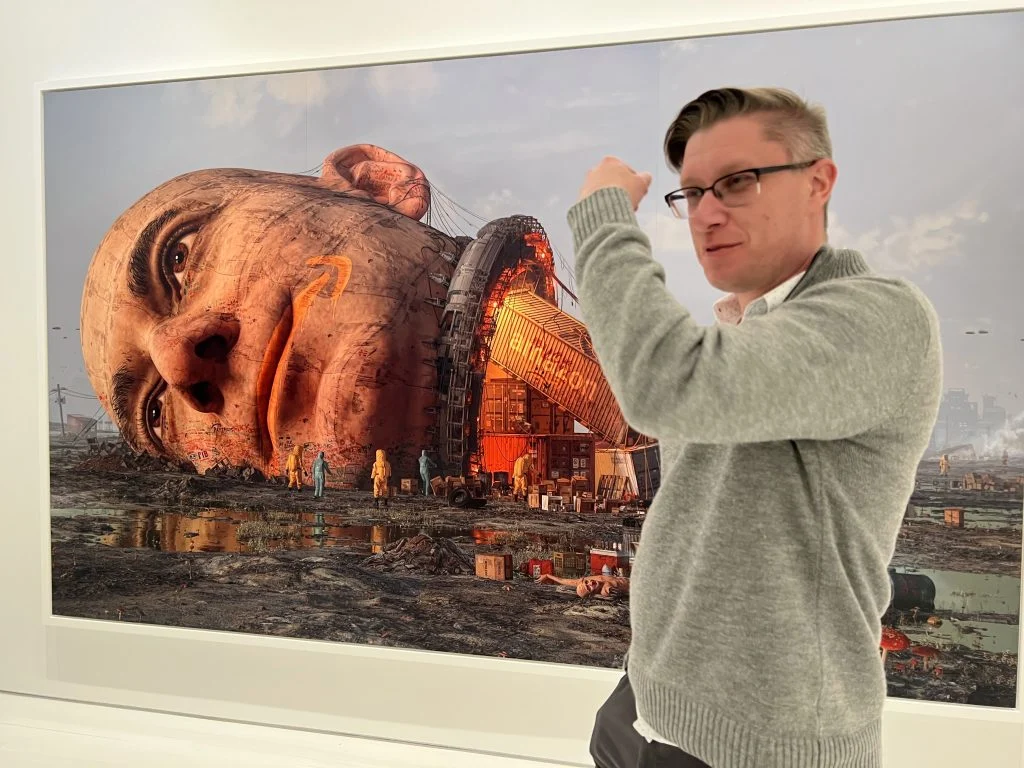- Beeple’s Everydays project showcased his commitment to daily digital art, eventually leading to a groundbreaking $69 million NFT sale.
- His success not only transformed digital art but also fueled the rise of NFTs and expanded their mainstream appeal.
Few stories in the realm of art have attracted as much worldwide interest as those of Mike Winkelmann, better known as his moniker, Beeple.
From humble beginnings in Wisconsin to achieving a groundbreaking sale at one of the world’s most prestigious auction houses, his rise to fame not only transformed the art industry but also helped solidify the presence of non-fungible tokens (NFTs) in the mainstream.
Marked by a mix of constant innovation and the perfect timing, Beeple’s path marks a new front in digital art and technology.
From Digital Designer to Everyday Creator: The Origins of Beeple’s Journey
The narrative of Beeple begins far from the flash of multimillion-dollar art sales. Mike Winkelmann, born in 1981, started his training in computer science first.
But his obsession with digital images drove him into a career as a graphic designer, working on several projects for firms like Apple and SpaceX. Still, he didn’t really start what would eventually be his “Everydays” project until 2007.
Beeple started producing brand-new digital artwork every day after taking inspiration from British artist Tom Judd. The concept was straightforward: regardless of the situation, he would create and distribute a fresh work of art every day without skipping any.
This dedication to consistency turned into a motivating factor in his creative path. His art developed in both complexity and subjects over time, frequently criticizing society, politics, and popular culture via hideous, apocalyptic imagery, including well-known people like Donald Trump and Jeff Bezos.
Beeple had created 5,000 similar pieces by the time 2021 arrived, which served as the basis for his most well-known work, Everydays: The First 5000 Days.
A Landmark Sale: How Beeple’s Digital Artwork Made History
March 2021 saw Everydays create history. Christie’s, one of the world’s oldest auction houses, hosted the sale of this entirely digital artwork as an NFT—a first for the auction house and the art world. The starting bid? A mere $100. However, by the time the bidding war concluded, the final price had skyrocketed to $69.3 million.
This sale wasn’t just a record for digital art—it was a landmark moment for NFTs. The buyer, Vignesh Sundaresan, a cryptocurrency investor known as MetaKovan, made the purchase using 42,329 Ether, emphasizing the role of cryptocurrency in this groundbreaking transaction.
The purchase solidified Beeple as one of the top three most valuable living artists, a position previously reserved for names like David Hockney and Jeff Koons.
Beyond the staggering price, what made this sale truly revolutionary was its format. Beeple’s work, unlike traditional paintings or sculptures, existed purely in the digital world. When Sundaresan acquired Everydays, he didn’t receive a physical object; instead, he received a token representing ownership of the digital artwork.
This paradigm shift represented a new era for the art world, where ownership of art could now be symbolized through a piece of code on the blockchain.
Beeple’s $69 Million Sale: Sparking a New Era for NFTs and Digital Assets
Beeple’s $69 million sale did more than just break records—it brought unprecedented attention to NFTs and the world of digital art. Artists, collectors, and investors suddenly saw the potential of NFTs as a way to buy, sell, and own art in a way that was previously unimaginable.
It wasn’t just about owning a digital file—it was about owning something rare and unique, something that could be verified and traded through blockchain technology.
Moreover, Beeple’s success story inspired many others, not only in the art world but also in the cryptocurrency space. His work showed that digital assets, like meme coins and other forms of digital collectibles, could carry immense value.
This led to a surge in interest in NFTs and digital currencies as people began to explore their potential as speculative investments.
Beeple didn’t stop at Everydays. In November 2021, he unveiled another groundbreaking piece titled Human One, a hybrid work combining physical and digital art.
This seven-foot sculpture, featuring dynamic digital images projected onto four video screens, was programmed to evolve over time, showcasing Beeple’s ability to merge traditional artistic concepts with cutting-edge technology.
The concept behind Human One was as innovative as it was ambitious—Beeple would continue updating the digital component of the piece even after the sale. In this way, the artwork would remain a living, breathing entity that evolves along with its creator’s vision.
This ability to fuse the physical and digital worlds further cemented Beeple’s status as a pioneer in the contemporary art scene. The piece sold for almost $29 million, proving that Beeple’s initial success was no fluke.
Criticism and Controversy: The Challenges of Beeple’s NFT Success
Despite his meteoric rise, Beeple’s success has not been without its detractors. Critics have raised concerns about the speculative nature of the NFT market, with some even questioning the long-term value of digital art. For some, Beeple’s $69 million sale was viewed as part of a larger hype cycle, where prices are inflated due to media attention and investor speculation rather than the intrinsic value of the art.
Others pointed out that both Beeple and the buyer, Sundaresan, had vested interests in the sale’s success. Sundaresan, through his investment in B20 tokens, benefited from the rising price of Beeple’s work during the auction’s media frenzy, although the token value later collapsed.
This led to accusations that the auction was, in part, a publicity stunt designed to draw attention to the NFT market.
Still, these controversies haven’t overshadowed Beeple’s impact on the art world. His ability to blend technology, art, and cultural critique has opened new doors for artists everywhere, offering a glimpse into what the future of art could look like.





